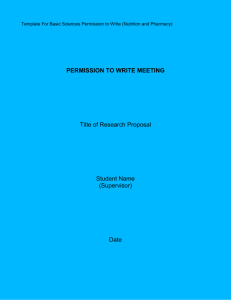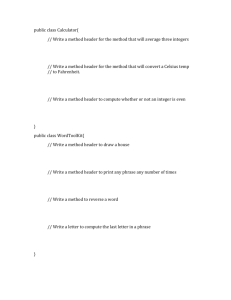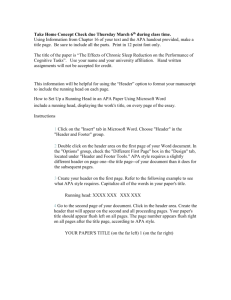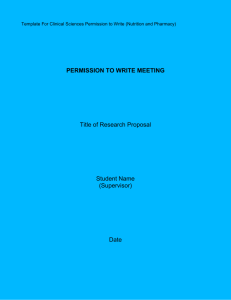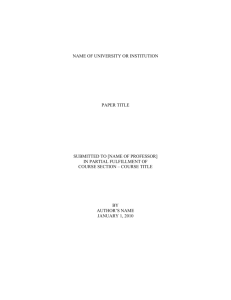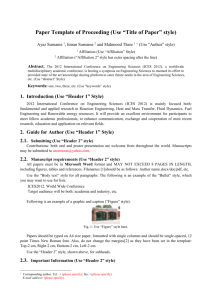First chapter
advertisement
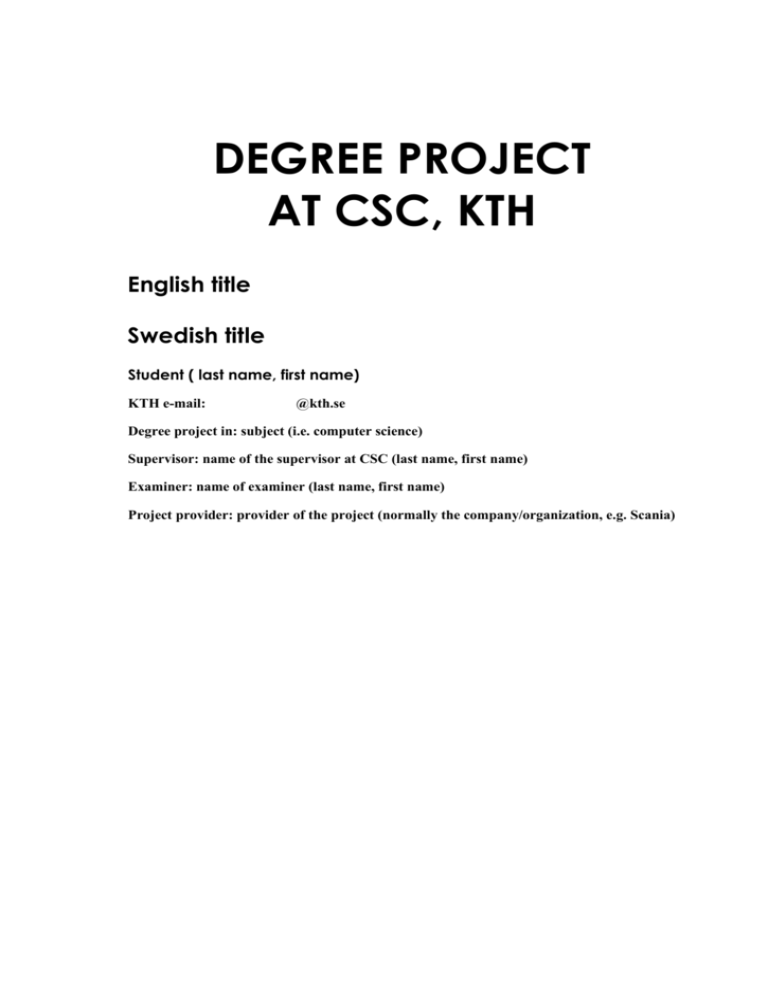
DEGREE PROJECT AT CSC, KTH English title Swedish title Student ( last name, first name) KTH e-mail: @kth.se Degree project in: subject (i.e. computer science) Supervisor: name of the supervisor at CSC (last name, first name) Examiner: name of examiner (last name, first name) Project provider: provider of the project (normally the company/organization, e.g. Scania) English title Abstract Abstract in English Swedish title Sammanfattning Absract in Swedish. This may be very short. If both absracts fit into one page, you place them on the same page. If not, you place the swedish abstract on a new page. Preface You put the preface on a new page. The preface is optional. Table of contents First chapter................................................................................................................................... 1 Subheading ................................................................................................................................ 1 Second chapter .............................................................................................................................. 2 Subheading ................................................................................................................................ 2 Lists ....................................................................................................................................... 2 Header and footer .................................................................................................................. 2 References ............................................................................................................................. 2 Tables .................................................................................................................................... 2 References ..................................................................................................................................... 4 First chapter First chapter You may have a short introduction to each chapter where you state what the chapter will cover. This introduction may be in italics. And here you write your first chapter – which is not necessarily the chapter that is written first. In this text I have chosen to have white space between the paragraphs. In your report you choose whether you want to mark the paragrahs with indentation or white space. If you choose to use indentation, it should be about the same as the base line distance. And here you write your first chapter – which is not necessarily the chapter that is written first. In this text I have chosen to have white space between the paragraphs. In your report you choose whether you want to mark the paragrahs with indentation or white space. If you choose to use indentation, it should be about the same as the base line distance. You probably have some subheadings, too. Subheading Concepts that are difficult to explain are often more easily understood if you illustrate with an example or a figure. Principles of functioning are often best illustrated using block diagrams or flowcharts. Some illustrations are definitively necessary for the user to understand the text. Anything that is illustrated in a figure must also be described in the text. You must have a reference to the figure in the text so that the reader knows when to study the figure. All figures should be numbered and have a legend. The legend is normally written beneath or beside the figure. Place the figures as close as possible to the text that they illustrate. Figure 1: Screen dumps can usually be reduced to about 70% size. You may save your document using Spara in the Arkiv-menu. See figure 1. Your text may contain words that you want to mark especially, e.g. menu alternatives. These words may be given a character style. This is what I have done with two of the words in the paragraph above. . 1 Second chapter Second chapter You may choose to start each chapter on a new page. Subheading Lists Lists are frequent elements in scientific reports. Usually they are written in the manner below. Please note that there is slightly more white space before the first item and after the last item. • • • First item. Next item. If the text is long enough to fill more than one line, the second and following lines will be indented. Last item. And here is normal paragraph just in order to show the white space. Header and footer You design your headers and footers. But the report must have page numbers, starting with the first page of the first chapter as page 1. And the page numbers must be centered. You decide whether the page numbers are in the header or in the footer. You may have your name, the title of the chapter or the report in the header. In this case it is often a good idea to use a thin line to separate the header from the text. If you want the chapter title in the header each chapter has to be a separate section. Low level subheading You may have headings of up to a maximum of five different levels. The above heading is on level 4. It is not necessary to include headings of all levels in the list of contents; the list of contents gives less overview if it is long. The list of contents often gives a better overview if it is not so long. A second paragraph. References There are several ways of writing references in the text. The, in my opinion, best way is to write the last name of the author and the year in parenthesis (Pettersson, 2000). If the name of the author needs to be included in the text to make if readable, it should be before the parenthesis. Andersson (1999) has through thorough testing verified that the xyz-algorithm is 23% faster. Tables Tables are common in scientific reports. Table 1 shows that extra insulation of houses may pay off. There should not be a page break within the table (unless it is too big to fit into one page). The legend must be on the same page as the table, and is usually placed above. 2 Second chapter Table 1: Consumption of electricity in kWh in three different private homes through the years 1995–1999. All three houses had extra insulation in 1997. År 1995 1996 1997 1998 1999 Hus 1 13500 10200 9300 9800 8900 Hus 2 18500 18200 13100 14500 12800 Hus 3 33800 28600 23400 22600 23100 3 References References ANDERSSON, P. 1999. Testing algorithms. Journal of algorithms, Vol. 4, 1999, s. 217–223. ANGEL E. 2011. Computer graphics, a top down approach. Prentice Hall. ISBN 123456789. A modern and frequently used text book on computer grahics used in courses at KTH MORKES J. OCH NIELSEN J. 1997. Consise, scannable, and objective: how to write for the web. http://www.useit.com/papers/webwriting/writing.html Article by the web guru Jakob Nielsen on how to write web pages. Describes two experiments testing legibility of web pages.. PETTERSSON, A. 2000. Writing scientific reports. Studentlitteratur. ISBN 123456789 This is a fake that does not exist. 4


